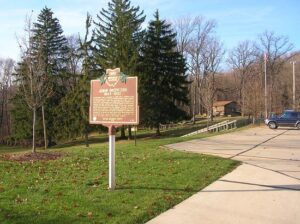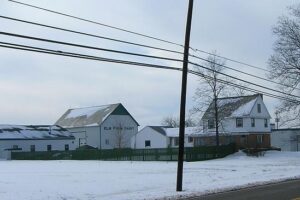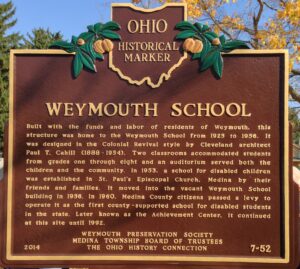, OH
Seville’s most famous residents, Captain Martin Van Buren Bates (1845-1919) and Anna Swan Bates (1848-1889) settled here in 1873. Their notoriety stemmed from their dramatic stature: Martin, a former Confederate soldier from Kentucky, stood 7 feet 8 inches tall; Anna, a would-be teacher from Nova Scotia, stood 7 feet 11 inches tall. They met on the carnival circuit in New Jersey in 1871 and wedded in England the same year in a ceremony orchestrated by Queen Victoria. (Continued on other side)
, OH
As a member of the Connecticut Land Company, Judge Samuel Hinckley of North Hampton, Massachusetts purchased township 4N Range 13W of the Western Reserve in 1795 for a sum equivalent to 23 cents an acre. The township remained unsettled until Abraham Freeze was commissioned by Judge Hinckley in 1819 to survey the township into 100 plots of 160 acres each. In return for having the township, founded in 1825, named “Hinckley,” the judge gave land for two burying grounds and one-half acre for a public square. In 1919, upon the 101st anniversary of the “Great Hinckley Hunt,” where men from surrounding counties gathered on Christmas Eve to rid the township of wild animals, Judge Amos Webber spoke for the deceased Judge Hinckley: “When I last saw this country, it was a howling wilderness – by industry and frugality you and your ancestors have made these ever lasting hills and pleasant valleys blossom as the rose.”
, OH
Daniel E. Weltzien, pilot and hometown son, dreamed of a flying community – one where every family would have a plane in their garage for work or play. In June 1965, the Williams Farm on Acme Hill became a runway with taxiways to every home. Young men and women came for flying lessons, and now traverse the world in space, the military, and commercially. Surviving fire, tornadoes, an earthquake, Ohio winters, and severe crosswinds, students still come here to take their first flight and become pilots. In Ohio, birthplace of aviation pioneers, this is “SKYPARK” THE FLYING COMMUNITY, a first in Ohio because a man dared to dream.
, OH
Heritage Farm is a typical mid-19th century farm of the Ohio Western Reserve and has been restored and preserved. The original parcel of land consisted of 325 acres, which was purchased by David Berdan in 1818. The farmstead has been home to Abram and Sarah Berdan, William and Rachel Pitkin, George and Julia Tibbitts, and Peter and Mary Groening. The Heritage Farm Museum site consists of 4 acres with a house, privy, carriage house, corncrib, granary, equipment shed, barn, milk house, and chicken house, and was open to the public on July 1, 2000.
, OH
In 1927, Henry Abell, a master plumber, purchased a 100-acre dairy farm. When the Great Depression struck the nation two years later, Abell could find little work as a plumber and decided to develop his dairy farm. In 1934, he and his family began the Dairy, growing the farm to 500 acres and producing enough milk, ice cream, and other dairy products to supply five counties. The dairy closed in 1979, but today houses America’s Ice Cream and Dairy Museum, dedicated to the cultural history of the ice cream and dairy industry in Ohio and the United States.
, OH
Seba Bronson Jr. left Columbia Township in early 1810 and followed the Rocky River to an area one and a half miles north of here. He built a cabin and planted a crop and thus started what became known as the village of Hardscrabble in Liverpool Township. The village was centered around the Columbia/Grafton Road area, and the township is the oldest continuously inhabited township in Medina County. The Potawatami Indians occupied this area and camped annually along the Rocky River. For five silver dollars, they showed Seba and a partner a hidden salt springs which they sought to exploit. Other men also scrabbled to own it and Justus Warner succeeded. Seba was turned out. Warner operated the Liverpool Salt Works beginning in 1811. The first industry in the county, salt was a necessity and eagerly sought by setters in the area.
, OH
Built with the funds and labor of residents of Weymouth, this structure was home to the Weymouth School from 1925 to 1956. It was designed in the Colonial Revival style by Cleveland architect Paul T. Cahill (1888-1954). Two classrooms accommodated students from grades one through eight and an auditorium served both the children and the community. In 1953, a school for disabled children was established in St. Paul’s Episcopal Church, Medina by their friends and families. It moved into the vacant Weymouth School building in 1956. In 1960, Medina County citizens passed a levy to operate it as the first county-supported school for disabled students in the state. Later known as the Achievement Center, it continued at this site until 1992.
, OH
Around 1900, the newly formed Litchfield Cemetery and Park Association needed a band to lead processions to and from the town cemetery on Memorial Day. The Litchfield Town Band was born. Urial Crow served as its first director, so the group was sometimes known as “The Crow Band”. Although there were periods when the band was inactive, it has been a community institution for more than a century. The group plays a broad repertoire of standards and marches by John Philip Sousa at Memorial Day and other commemorations, ice cream socials, and various community events. Directors have included Urial Crow, Loren Hayes (c. 1915), Floyd Koons (mid-1920s), Raymond Bradley (1935-1939), Hal Leach (1939-1945), Kenneth Bradley (1946-2011) and Cynthia Bennett (since 2012).









